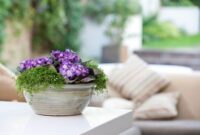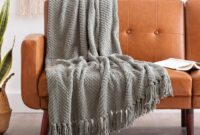Textured wall treatments for added dimension bring a new level of visual interest to any space, creating depth and character that captivates the eye. From Venetian plaster to faux brick, explore the world of textured walls and discover how you can transform your surroundings with these innovative techniques.
Dive into the realm of textured wall treatments and unlock the secrets to elevating your home décor to a whole new dimension.
Types of Textured Wall Treatments

Adding texture to walls can significantly enhance the overall aesthetic appeal of a space by creating depth and visual interest. There are various types of textured wall treatments that can be used to achieve this effect.
Venetian Plaster
Venetian plaster is a classic textured wall treatment that involves applying multiple layers of a polished plaster mixture to create a smooth and marble-like finish. This technique adds a sense of luxury and elegance to a room, making it a popular choice for high-end interiors.
Faux Brick
Faux brick is another popular textured wall treatment that mimics the look of real brick without the weight or cost associated with traditional masonry. This treatment adds a rustic and industrial charm to a space, perfect for creating a cozy and inviting atmosphere.
Shiplap
Shiplap is a type of wooden board commonly used in exterior siding, but it has become increasingly popular as an interior wall treatment. Installing shiplap involves overlapping boards to create a distinct horizontal pattern, adding a touch of farmhouse chic or coastal charm to a room.
Each of these textured wall treatments offers a unique way to add dimension and character to a space, allowing for endless design possibilities to suit different styles and preferences.
Materials and Tools for Textured Wall Treatments
When it comes to applying textured wall treatments, having the right materials and tools is crucial for achieving the desired effect. The choice of materials will determine the texture and finish of the wall, while the tools play a key role in the application process.
Essential Materials
- Joint compound or plaster: These materials are commonly used to create texture on walls. Joint compound is easier to work with for beginners, while plaster offers a more durable finish.
- Texture paint: Specialized texture paints are available in various finishes such as sand, popcorn, or knockdown textures.
- Primer: A good quality primer is essential to ensure proper adhesion of the texture material to the wall surface.
- Additives: Depending on the desired texture effect, additives like sand, sawdust, or glitter can be mixed with the texture material.
- Protective gear: Safety glasses, gloves, and a dust mask are important when working with textured materials.
Importance of Choosing the Right Materials
Choosing the right materials is crucial for achieving the desired textured effect on walls. Different materials will result in different textures, so it’s important to consider the look you want to achieve before selecting the materials. For example, joint compound can create smooth or subtle textures, while plaster is better suited for more pronounced textures. Texture paints offer a variety of finishes, from fine to coarse, depending on the texture particles used.
Role of Tools, Textured wall treatments for added dimension
- Trowels: Trowels are essential for applying joint compound or plaster to create textured patterns on the wall.
- Sponges: Sponges can be used to dab or swirl texture material on the wall to create unique patterns and finishes.
- Brushes: Brushes are useful for creating stippled or brushed textures on walls, adding depth and dimension to the surface.
- Rollers: Texture rollers are handy for applying texture paint evenly on large wall surfaces, creating a consistent finish.
- Texture sprayers: For larger projects, texture sprayers can be used to apply texture material quickly and efficiently.
Application Techniques

When it comes to applying textured wall treatments, the technique used can greatly impact the final result. Whether you’re going for a subtle texture or a more dramatic effect, the application method plays a crucial role in achieving the desired look.
Step-by-Step Application Process
- Prepare the surface: Make sure the wall is clean, dry, and free of any dust or debris.
- Apply the base coat: Use a roller or brush to apply a base coat of paint or primer to the wall.
- Choose your technique: Depending on the desired texture, choose a technique such as stippling, ragging, or combing.
- Apply the texture: Use the chosen tool or method to apply the texture to the wall, working in sections to ensure even coverage.
- Allow to dry: Let the textured wall treatment dry completely before adding any additional layers or finishes.
Tips for Professional Finish
Ensure consistency: Maintain a consistent pressure and technique throughout the application process to avoid uneven textures.
Practice on a small area: Before tackling the entire wall, practice the chosen technique on a small section to perfect your method.
Blend edges: To avoid visible seams or lines, blend the edges of each section as you work your way across the wall.
Comparison of Techniques
- Stippling: Involves dabbing a brush or sponge onto the wall to create a textured effect. Ideal for creating a subtle, mottled finish.
- Ragging: Uses a rag or cloth to apply and manipulate the texture on the wall, resulting in a soft, blended look.
- Combing: Involves dragging a comb-like tool through wet paint or plaster to create linear or geometric patterns on the wall.
Color and Texture Combinations: Textured Wall Treatments For Added Dimension

When it comes to textured wall treatments, the choice of colors can significantly impact the overall look and feel of a space. By combining different colors with various textures, you can create a dynamic and visually appealing design that adds depth and dimension to the room.
The relationship between color palettes and textures is crucial in achieving a cohesive and harmonious design. The right combination of colors and textures can enhance each other, creating a balanced and unified look. For example, pairing a rough, stone-textured wall with earthy tones like beige and brown can evoke a sense of warmth and coziness in a living room or bedroom.
Successful color and texture combinations often involve contrasting elements that complement each other. For instance, a smooth, metallic-textured wall in silver or gold tones can create a striking contrast with a matte, dark-colored accent wall. This juxtaposition adds interest and drama to the space, making it visually stimulating and unique.
Examples of Successful Color and Texture Combinations
- Combining a rough, textured wall with a soft, pastel color palette for a soothing and relaxing atmosphere in a spa or bathroom.
- Pairing a glossy, sleek texture with bold, vibrant hues like red or teal for a modern and energetic look in a commercial space or office.
- Using a subtle, sand-textured wall in neutral shades like gray or taupe to create a sophisticated and understated backdrop for a minimalist or contemporary decor.
Elevate your interior design with textured wall treatments that add a touch of sophistication and style. Embrace the versatility of textures and colors to redefine your living space and make a lasting impression on all who enter.
When it comes to interior design, one popular style that never goes out of fashion is mid-century modern furniture and décor. With its sleek lines, organic shapes, and minimalist approach, this design aesthetic adds a touch of retro charm to any space.
For those who prefer a more rustic and cozy ambiance, exploring rustic farmhouse interior design ideas can provide plenty of inspiration. Incorporating natural materials, vintage accents, and warm earthy tones, this style creates a welcoming and homely atmosphere.
Looking to bring a sense of tranquility and simplicity into your home? Consider incorporating Japanese zen home décor ideas. With a focus on minimalism, natural elements, and a harmonious balance of space, this design philosophy promotes a serene and peaceful environment.




